Archery Targets
The History of Archery Targets
We may or may not take our modern archery targets for granted today. But how did these targets evolve? What did people in ancient and medieval times use as targets when they practiced archery? The types of archery targets varied even more so than the types of bows used by various people. This article explores the evolution and various types of archery targets from around the world!
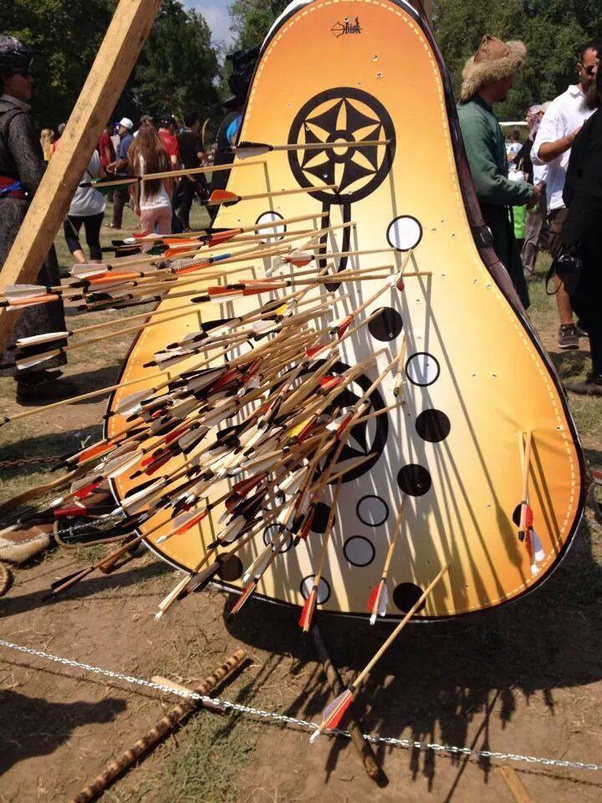
Types of Archery Targets From Around the World
As previously mentioned, archery targets came in a wide variety, yet they also share some common elements. They had to be durable enough to take repeated arrows and some materials that are commonly available around the world can make a suitable target material.
Other than the material they are made of, the other consideration would be the size and shape of the target. As with modern three-dimensional targets that usually emulate hunted animals, archery targets from times past also had certain shapes specifically chosen for their visual appeal. Finally, some targets were used to test the power of the bow by measuring its penetration of a certain material. The following sections summarize some archery targets used in the past from different places across the globe.
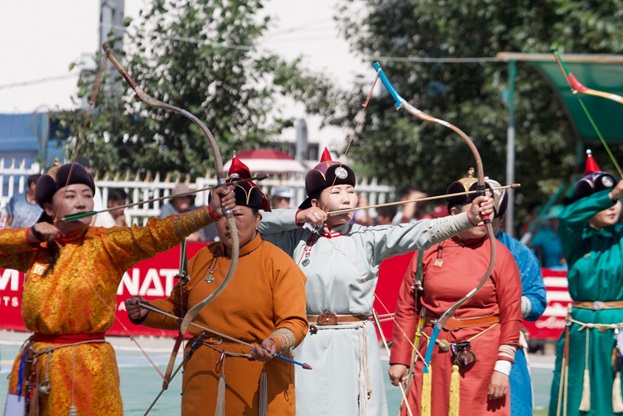
Archery Targets in Medieval Europe
Some of the first types of targets recorded to be in use in medieval Europe were simple earth mounds. These earthen mounds were known as “butts”. Mounds of clay were also used, which were wetted prior to shooting.
The below image from the Luttrell Psalter, which was written sometime in the 1300s, illustrates archers practicing. They shoot at a large, round earthen mound. Small wreaths are placed in a central location on the mound to indicate the actual center of the target.
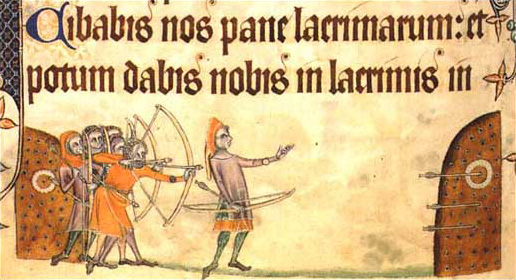
The Iconic Circles
If you asked the random, average person, what an archery target looked like, they would very likely be reminded of the iconic concentric circles. The “golden eye” or yellow circle in the center, with various colored rings moving farther outwards. These targets have been in use for quite some time and were eventually standardized by the World Archery Federation (previously FITA, Fédération Internationale de Tir à l’Arc).
From about the 1700s onwards a common archery target was made using coiled straw. The straw was wound into a circle, covered in cloth with concentric circles painted on it, and finally placed on an easel. The target could be conveniently carried around and repositioned on the range. The process of making these types of targets by hand was very time-consuming. These targets are still made to this day with the aid of modern machinery.
It was in the 1800s that the Royal Toxophilite Society of England standardized some aspects of target archery including standard distances and a standardized scoring system. Below is a modern archery target and the corresponding scoring/point system.

Archery Targets in Egypt
The ancient Egyptians were very fond of archery. Check out our article on Egyptian archery for more information. Archery was definitely practiced on a regular basis, by the Pharoah and common folk alike. What materials they used for archery targets is however not very well documented.
There are several examples of hieroglyphs and carvings which depict Egyptian archers in action, some of which show them shooting at targets. The targets are relatively large and are also placed on easels or stands. Placing the target on a stand seems to be a practice going back several thousands of years.
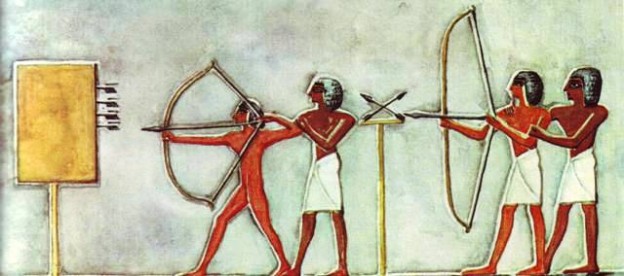
The Pharaohs would compete in archery competitions as well. They did not compete with just anybody though. They would try to best their ancestor’s feats in archery. This tradition appears to have begun with the 18th dynasty pharaoh Tuthmosis III (1425–1398 BC) who is said to have shot an arrow through a copper plate “three fingers thick”.
Traditional Mongolian Archery Targets
Like many groups of people, the Mongolians are a nation of archers and have been so for a very long time. Since achieving national independence, a revival and interest in the old ways of Mongolian archery proceeded. The Mongolian government has promoted and encouraged this revival. Every year in the summer there is a large national festival known as Nadaam. The three main competitions include horseback riding, wrestling and of course, everyone’s favorite, archery.
The target or rather targets in a traditional Mongolian archery contest are quite unique. Firstly, there are three similar styles of shooting in a traditional contest. They are called Uriankhai archery, Buriad archery, and Khalkh archery, which are all names of Mongolian tribes. Urankhai archery is traditionally only shot by men at 40 meters. The targets are small balls made from a leather strap called “chikh”. These balls are arranged in a line. If the balls are struck and roll 20 centimeters backward a point is registered.

The other two styles involve shooting at rows of small cylinders called “hasaa”. Also made of leather, these 8 cm by 8 cm cylinders are placed in a line and stacked one on top of the other. If a hit is made the cylinder must move from its original position by 8 cm to register a hit.
A group of judges (surchid) stand near the targets and indicate with body language and/or hand gestures the results of a shot. Raising both arms in the air with palms outward and yelling “Uukhai” indicates a successful shot. If the shot flies over the judge will slide their hand palm down over the targets indicating the length that the arrow flew over. If the arrow falls short of the target the judge will show the length of the gap with their arms.
Traditional Korean Archery Targets
When it comes to archery, Koreans excel at both their traditional craft and modern Olympic archery styles. Archery has been practiced in Korea for millennia and it is the country’s national sport. Apparently, during a visit from Prince Heinrich of Prussia in 1899, Emperor Gojong of Korea was convinced by the visiting diplomat to make archery the national sport. Since then a great effort to standardize traditional Korean archery has taken place.

The traditional Korean archery range using the Gakgunk (traditional Korean bow) has targets set at a standard 145 meters! This is what we would call long rang target archery! Read more about traditional Korean archery here.
The targets themselves are about 2 meters across by 2.66 meters tall. They have a distinctive black square with a red circle in the center. The arrows used in traditional competition are rubber-tipped so they bounce off the target. Hitting the target anywhere results in one point, and missing the target does not register a point.

Traditional Japanese Archery Targets
In Japanese traditional archery or Kyūdō, there are several variations of targets or mato. The first target to be mentioned is the one likely to be used by the beginner to develop their technique. The Makiwara,巻藁, is a close-range target shot at from approximately 7 feet or from the length of one’s bow (yumi) from the center of one’s body. Makiwara means rolled up straw, which is essentially what the Makiwara is. This archery Makiwara is not to be confused with the Makiwara in karate. These targets come in standard sizes:
[Diameter x Length]
1) 45cm x 40cm
2) 36cm x 75cm
3) 45cm x 75cm
On occasion, a larger 150-centimeter target is used for Enteki or long-distance shooting. Distances vary between 90m, 70m, 60m, or 50m with most dojo or training halls set up for 60 meters. However, these long-range targets are typically 36 cm with a paper covering which is called matogami. The most common of these paper coverings is either the kasumi-mato (mist target, below left) and the hoshi-mato (star target, below right).
.
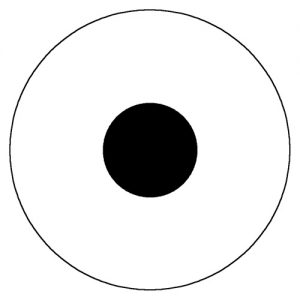
The Makiwara is placed on a wooden stand called makiwara-dai (巻藁台). These stands are made to be the height of the archer practicing on them.
Most mato consists of a simple wooden frame (matowaku) and a paper covering (matogami).
Traditional Turkish Archery Targets
Four main types of traditional Turkish archery prevailed. The first was flight shooting, where no target is required. The next three are considered target archery, and they are darb (piercing), puta shooting, and horseback shooting.
Darb or pierce shooting developed from military training, which emphasized the ability to pierce armor. Common targets included small metal objects such as bells.

Puta shooting derives its name from the actual target which is called a puta. These objects are basically leather bags filled with seeds. The shape of a puta is unmistakable. It is said that the shape was derived from the shape of the frontal silhouette of a person mounted on a horse.
These puta targets are shot at from about 150 m to 250 m and are about 100 cm by 75 cm in size.
Modern Archery Targets
Modern archery targets come in a variety of forms and flavors. Most are made of synthetic foam. This foam can be layered together to make it able to catch crossbow bolts. Three-dimensional archery targets are also readily available. They also come in a variety of shapes, from game animals to fantastic beasts. Most have removable and replaceable target sections so you can easily replace these when they wear out.

Archery Targets DIY
There is a plethora of information out there on constructing your very own archery targets. ArcheryHistorian.com will likely create some content which dives deeper into the subject of DIY archery. :
